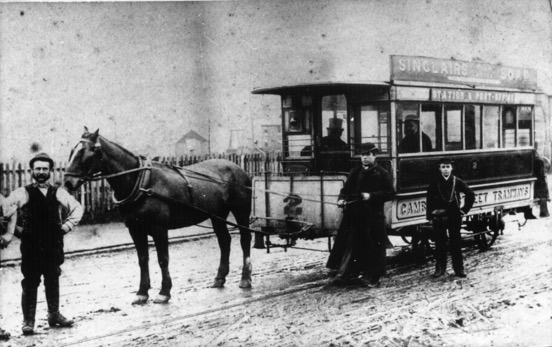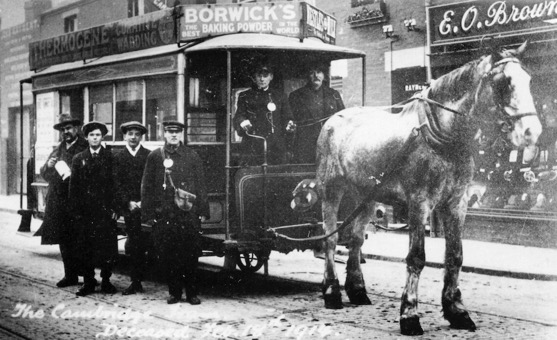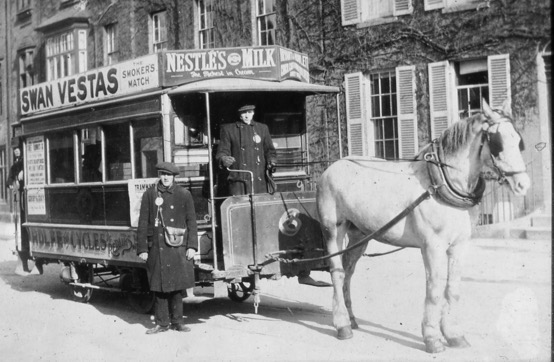The Tram Depot is a pub steeped in history – originally the stables for Cambridge Street Tramways who operated a horse-drawn tramway service from 1880 to 1914. There’s an original section of track by the front door leading to a former tram shed, and you’ll find a life-size model tram coming out from the front of the pub! The Tram Depot is an iconic building within the stunning city of Cambridge.
The railway station in Cambridge is over a mile from the city centre so it is not surprising that trams were considered to connect them. In 1878 two proposals were put forward, one for an extensive narrow gauge network and one for a simple standard gauge tramway. It was the latter that was accepted albeit revised to narrow gauge and the Cambridge Street Tramways Company was formed the following year, with the Cambridge Street Tramways Act receiving Royal Assent on 21st July 1879, construction work having commenced a two weeks earlier.
The actual gauge used was 4ft and the system consisted of two routes totalling 2.67 miles of single track with passing loops. It used 71 lb per yard girder rail spiked to transverse sleepers, substantial for a horse tramway but possible steam operation in the future was anticipated. The road area immediately adjacent to the rails was laid with granite sets and the rest in tarmac. With a construction speed typical of those days, but so rare today, the first line opened for traffic on 28th October 1880. This ran from the Railway Station, along Station Road and Hills Road (where there was a short section of double track) to Hyde Park Corner, then along Regent Street and St. Andrews Street to terminate by the Post Office. The second route opened a few weeks later and ran from East Road (by Fitzroy Street) and Gonville Place to Hyde Park Corner then along Lensfield Road, Trumpington Road, Trumpington Street and Kings Parade to end at Market Hill. At the crossroads at Hyde Park Corner there was a junction which allowed trams to turn in three of the four possible directions (see plan). The passing loops were at the north end of Lensfield Road, in Station Road, at the north end of Regent Street, in Gonville Place and in East Road just south of the depot. Two extra loops on the Post Office route were added in 1909 at Emmanuel College and in Regent Street. There were two tracks at the termini at East Road and Market Hill.
The depot, stables and offices were, and still are, at 184 East Road, although prior to the two track depot building opening in 1881, trams and horses were kept at the goods yard of the Great Northern Railway. Work commenced on the stables on 20th October 1880 and the Cambridge Chronicle & University Journal at the time stated that there would be “ample room for between 20 and 30 horses, together with smithy, washer’s room, corn and hay stores, and a large car shed, and suitable accommodation for the use of the Company”, the latter being for offices and a dwelling for the Traffic Manager, and the hay store being the upper floor of the car shed. A small building adjacent to the car shed was a ticket office. In 1883 early company profits were spent on improving the quality of the stables to hold the by then enlarged stock of horses. On 13th May 1914, after the tramway closed, the buildings were sold. The depot was used by V.Prior as a fish market until 1928 and then became a corn-chandlers. From 1938 it was used by a motor engineering company. From 1944 it was used by Peaks furniture dealers as a depository. By the 1970’s the buildings had become derelict. At some point the smithy was removed and in the 1980s the ticket office, which until then had been used as a shop, was demolished and that area redeveloped as new offices. However in the 1980s the three remaining tramway buildings, the car shed, the offices and the stables were very extensively renovated and today form offices, and The Tram Depot public house.
The pub sits next to the Anglia Ruskin University and welcomes its students as well as tourists and locals, attracting people from all walks of life. The Tram Depot has a vibrant, warm friendly atmosphere, full of character and charm with subtle nods to its history thanks to the interior décor.
History information from tramwayinfo.com




